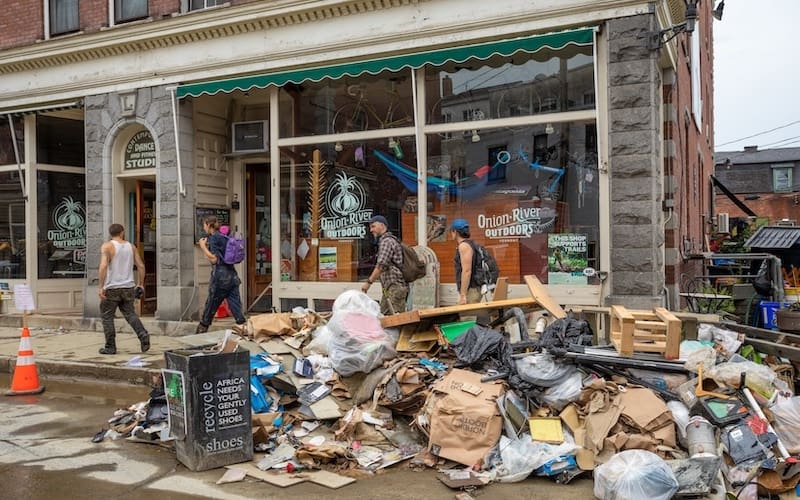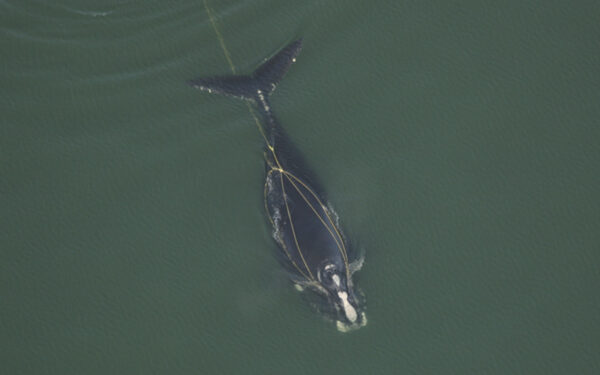
Residents of Vermont, like those of many other states hit by extreme weather, fires, and floods, have been grappling with how to clean up afterward. Photo: Shutterstock
Two days after floods devastated Montpelier, Vermont, in 2023, debris and a thick carpet of river mud choked downtown streets. Piles of wreckage included almost everything you can think of – sheets of pink fiberglass insulation, wood planks, old bicycles, sodden mattresses, plastic milk crates, rubber tires, furniture of every type.
It was a similar scene around the state after the floods of 2024. And after Hurricane Helene caused catastrophic damage across the southern United States. And after wildfires swept across parts of Los Angeles in 2025 – except that time, the rubble was blackened by fire.
Each time it happens, stunned communities ask themselves: How do we clean up from this?
There’s no easy answers, only more questions: Where do we put thousands of tons of debris? How do we preserve the purity of water and air? How do we ensure that regular people of moderate means can bounce back and rebuild just like their wealthier neighbors?
As the pace of extreme weather picks up, these questions stand front and center, not only in conversations in living rooms but in town halls and state legislatures. It’s time for us all to take a more systematic approach to natural disaster cleanup because we know by now that the latest calamity caused by our changing climate is not just a one-off. Scientists have said we can expect more extreme weather as climate change ramps into high gear. It’s time to find long-term solutions to these obvious but hard-to-resolve questions.
Question 1: What to Do with Toxic Debris After Disaster Strikes?
After the floods in Vermont, towns across the state grappled with what to do with the wreckage. That included hazardous materials such as old electronics, heavy metals, solvents, pesticides, heating oil, and microplastics. Between late July and mid-September 2023, subcontractors working with the state government removed more than 6,000 tons of debris, according to data collected by the VTDigger.
Where did that waste end up? Much of it was carted off to the Coventry landfill in Newport, Vermont. But that’s not the end of the story. Like every landfill, Coventry leaches toxic garbage juices into Vermont’s soil and the toxins end up in our water. And that leachate contains the chemicals from the products buried in the landfill – including PFAS, which have been linked to cancer and other serious health issues. Although Coventry has now installed a PFAS treatment system, it doesn’t remove all PFAS.
Sadly, this is just another downstream effect of this wave of “unnatural” disasters. (Because it’s clear the pollution humans have caused has contributed to extreme weather.) In Los Angeles, wildfires consumed more than 10,000 homes, leaving massive quantities of toxic rubbish behind. Piles of scorched wood, twisted metal, and hazardous ash had to be “burrito-wrapped” in plastic and hauled away. But to where? In fact, the EPA hauled the most dangerous garbage to neighboring cities that were not happy to be on the receiving end of this toxic surprise.
“While the Cities are completely in solidarity with our neighboring communities, we are extremely disappointed with the lack of respect to our local residents for not being notified of the EPA’s clean-up efforts and having toxic materials transported to our backyards,” officials from four cities wrote in a statement.
It’s time we admit that unnatural disasters leave towns in rubble, and that rubble is usually buried or burned. And that creates more problems (and pollution) for everyone else.
Question 2. How Can We Protect Our Water and Air After Disaster Strikes?
Water contamination has been a big issue in Vermont since the floods. And it’s not just a result of toxins filtering into the soil from areas where hazardous debris has been dumped. In 2023, 28 wastewater treatment facilities broke down because of flooding or high flows, leading to raw sewage spills. In 2024, nine facilities broke down. Millions of gallons of untreated sewage have spilled into Vermont waterways in the past two years. Some have flowed into Lake Memphremagog after a wastewater treatment facility failed.
That exposes the public to all sorts of noxious chemicals, including those from cleaning supplies, industrial waste, and sewage.
Because of the repeated flooding in recent years, water districts in Vermont have detected elevated levels of harmful chemicals in public drinking water systems. The extreme flooding, combined with the warmer winters due to climate change, means more organic matter is being swept into lakes and rivers. When water authorities add chlorine to public water supplies to kill bacteria, it interacts with the organic material to create other toxic chemicals called trihalomethanes. People who drink water with this chemical over a long period may, according to the letter sent to water customers in one Vermont district, “experience problems with their liver, kidneys, or central nervous systems, and may have an increased risk of getting cancer.”
Of course, Vermont is not alone in this. The noxious fallout of unnatural disasters spares no one. Similar problems arose across the South following Hurricanes Helene and Milton. After the LA wildfires, particulate matter from burned structures led to high levels of toxic chemicals like lead, polyaromatic hydrocarbons, and asbestos in the air. Residents have been told they must be extra vigilant about air quality for months.
The truth is that climate-change-fueled unnatural disasters cause more air and water pollution, which increases the potential for even more extreme weather.
Question 3: How to Recover Equitably?
Problems with air and water pollution are acute, but there is another pernicious effect after unnatural disasters. How fast survivors can recover, whether they will receive funds to rebuild, whether they carry insurance on their property, and whether they can find even just a place to stay often depends on how wealthy they are. In Los Angeles, survivors of a fire in affluent Pacific Palisades had the resources to rent or buy housing. (There were reports of residents renting homes nearby for as much as $30,000 a month.) Meanwhile, in the moderate-income neighborhood of Altadena, home to many Black and Hispanic residents, the talk often centered on leaving the area altogether. Newspapers reported that “real estate vultures” offering low-ball prices descended on the community. With critical funds from the Federal Emergency Management Agency stalled, and with the Trump administration playing politics regarding which states get assistance, cleanup after unnatural disasters is becoming even more inequitable.
The Final Question and Potential Answers
There is one final, thorny question: Should we be building in places – river corridors and brush-laden hillsides – if they are prone to floods and fires?
The commonsense answer is no. As we come to terms with what this might mean for the future, we must develop a multi-pronged, systematic approach. We must retreat from areas unfit to live in the age of climate change. (Many of us will be forced to do so as insurers refuse to insure homes in vulnerable areas.) We must retrofit our existing buildings and update our building standards to withstand intensified storms and heat. We must use fewer toxic PFAS-containing products that leach into soil and water. We must provide resources to strapped communities by passing more climate superfund laws like Vermont and New York, which require that polluters pay the costs of recovery following an unnatural disaster caused by their fossil fuel products. (The fossil fuel industry is challenging the law, as we knew it would, and the Trump administration has waged war against these laws, claiming state overreach.)
Here’s the thing: After flood waters recede and hot embers extinguish, the real work has only just begun. Let’s be honest about it, roll up our sleeves, and do what we can to limit unnatural disasters’ environmental and societal fallout.
This is one of an occasional series revealing the truth in environmental matters.



